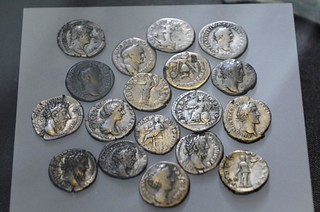
PREV ARTICLE
NEXT ARTICLE
FULL ISSUE
PREV FULL ISSUE
ALTERNATIVE CURRENCIES IN ANCIENT ROMAN WORLD
This article from the BBC History Magazine explores the history of alternate currencies, which are far from a modern invention.
-Editor
The Denarius In addition to these governmental currencies, there were other forms of money – gold, for example, likely acted as a form of money for large transactions. Other money-like objects have been found in many regions throughout the Roman world: thousands of small lead coin-like objects were found during building works in Rome in the 18th and 19th century, which are roughly the same size and bear similar designs to the smallest Roman coin – the quadrans, for example. Historians believe these must have acted as community or alternative currencies. Alongside the denarius, there existed many forms of community currency that facilitated transactions at a local level and contributed to a local sense of community. The bronze coins of Carthage continued to be used as money in Roman Africa for more than 100 years after Rome conquered the region in the second century BC, and Ptolemaic coins were used in Egypt well after the Roman conquest as well. These coins would have provided small change for these communities, but meant that the imagery of old, now defeated powers was used in a new context and invested with new meaning. Roman coinage was even used as small change in Africa as late as the 19th century!
‘Pseudo-mint’ The high volume of these coins in Pompeii has given rise to the idea that there was a ‘pseudo-mint’ in the town producing currency. This workshop was likely in operation in the first century BC, and produced alternative coinage that could act as change and be used for the payment of small, everyday transactions. Two different designs were produced, both adapted from the official currency of other cities. One type was adapted from the coinage of Ebusus in Spain (modern-day Ibiza). These coins are characterised by the image of the god Bes with hammer and snake, who is accompanied by other designs including a bull or a horse. Bes was an Egyptian god associated with the household and childbirth, but over time he came to be associated with protection from evil more generally; ancient Ebusus was named after him. The Pompeiian ‘pseudo-mint’ also produced coinage adapted from the currency of Massalia (modern Marseilles, France). These coins carried the head of Apollo on one side and a butting bull on the other. Why these particular coin types were chosen over others remains a mystery (perhaps Ebusan and Massalian coins entered the city with foreign traders, and was adapted from there). But the use of these coins from a ‘pseudo-mint’ in daily transactions must have meant that, over time, the images of Bes or the bull came to be associated with the city of Pompeii and its inhabitants, contributing to the formation of local identity. In a similar way, we today use coinage in Britain that carries the portrait of the queen. The existence of a currency likely only accepted in Pompeii and its surrounding areas would probably have benefited the local marketplace.
To read the complete article, see:
The Numismatic Bibliomania Society is a non-profit organization promoting numismatic literature. See our web site at coinbooks.org. To submit items for publication in The E-Sylum, write to the Editor at this address: whomren@gmail.com To subscribe go to: https://my.binhost.com/lists/listinfo/esylum All Rights Reserved. NBS Home Page Contact the NBS webmaster 
|
